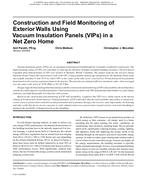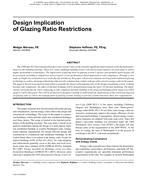-
-
Available Formats
- Options
- Availability
- Priced From ( in USD )
-
Available Formats
-
- Immediate download
-
$16.00Members pay $7.00
- Add to Cart
Customers Who Bought This Also Bought
-

Moisture-Related Durability of Walls with Exterior Insula...
Priced From $16.00 -

Effect of Natural Convection on the Thermal Transmittance...
Priced From $16.00 -

Construction and Field Monitoring of Exterior Walls Using...
Priced From $16.00 -

Design Implication of Glazing Ratio Restrictions
Priced From $16.00
About This Item
Full Description
The U.S. Department of Energy (DOE) outlined a path to advance high-performance and zero-energy homes in its BuildingAmerica research program (DOE 2008). That program -- and other efforts in the Unites States over the last few years to tightenenergy codes -- follow closely the evolution of energy standard developments in Europe. That is, developmentsmoved fromconventionalbuildings to low-energy buildings, then to passive buildings, net zero, and recently even plus energy. The common denominatoris low-load homes that require less energy fromthe start. Designing these homes requires specialized design tools to achievetargeted performance and quality assurance. The tools must enable the designer to meet the energy performance of the envelopeand the minimizedmechanical system and -- critically -- to achieve proper hygrothermal design of building skins before the detailedconstruction documents phase. The hygrothermal component reduces the risk of potentially catastrophic design flaws, therebyreducing risk for designers, builders, and homeowners.
The passive design approach offers a solid baseline for all low-load homes. The simplified static balance-based method hasprovided early adopters a useful tool. But it lacks the capacity to assess certain dynamic factors of the energy balance, such astransient effects that occur under real conditions -- for example, thermal lag time and related overheating in summer or the hygrothermalperformance of the building envelope.
This paper outlines the incorporation of the balance-based method currently employed to design passive buildings into hygrothermalwhole-building simulation software.A case study illustrates both methods as they are applied to an actual building. Additionalresults and insights from the dynamic building simulation are highlighted. The comparison of the balance-based methodwith the dynamic simulation, both performed within one tool based on the exact same building data and inputs, demonstratesbenefits and drawbacks as well as improvement potential for tools and methods moving forward. While the static monthly balancemethod simplifies the required steps and the time required to design a passive house, it might not be fine-grained enough for allclimate zones and building types. The results from the dynamic simulation are more granular and offer a more realistic depictionof the actual behavior of the building and its interaction with mechanical equipment in terms of comfort.
Presented at Thermal Performance of Exterior Envelopes of Whole Buildings XII, December 2013





